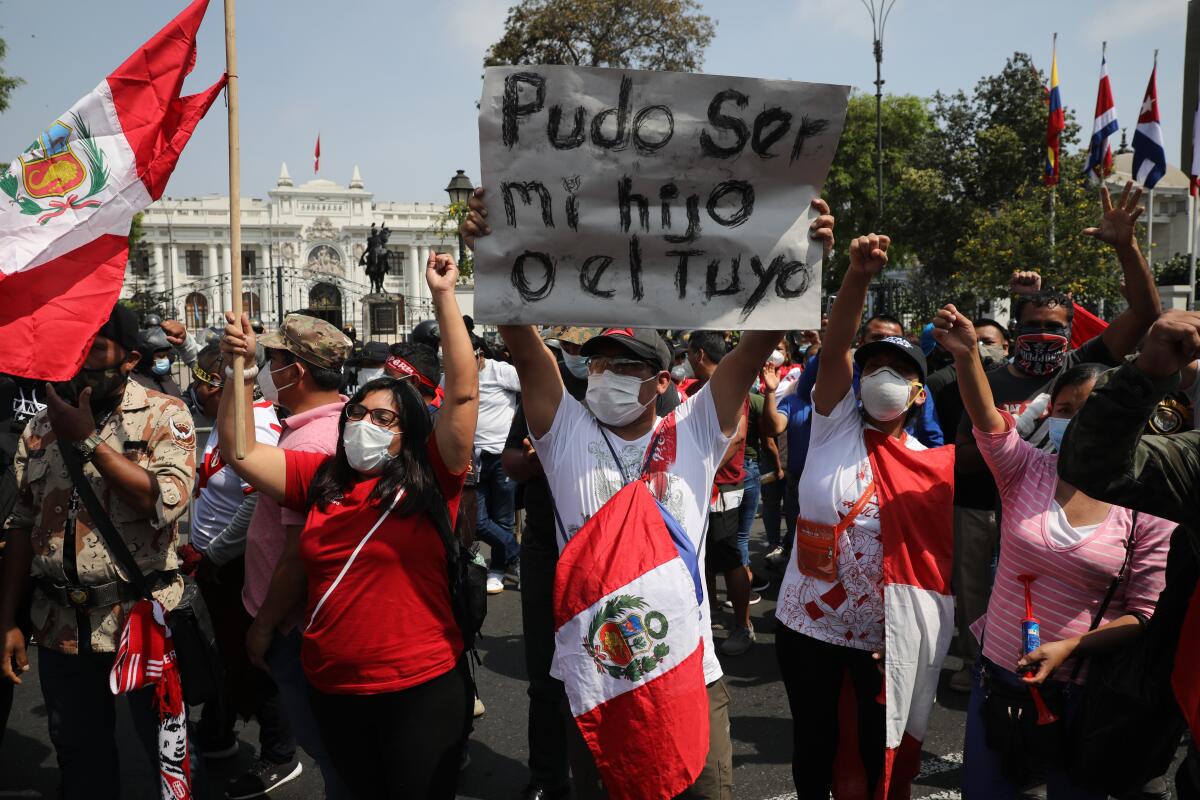Peru’s Congress selects centrist lawmaker to be new leader

- Share via
LIMA, Peru — Peru’s Congress chose a new leader Monday who is expected to become the nation’s third president in the span of a week, a hopeful sign that the political crisis is on the verge of resolution.
Lawmakers voted overwhelmingly in favor of Francisco Sagasti, an engineer from the centrist Purple Party, as the legislature’s new president. By law, the head of Congress should become the country’s new interim president.
It will now fall on Sagasti to heal a nation bruised by a week of upheaval. The 76-year-old hails from a political party that voted against Vizcarra’s ouster, which is likely to quell protests. He has worked at public and private institutions, including the World Bank.
“What’s at stake is making a first step toward rebuilding confidence between the people and the state,” said Samuel Rotta, president of the Peruvian chapter of Transparency International.
Applause erupted in the legislative palace as Sagasti clinched the required majority vote. It was unclear how soon he might be sworn into office.
The Latin American nation’s political turmoil took a chaotic turn Sunday when interim leader Manuel Merino quit and Congress couldn’t decide on his replacement. That left Peru rudderless and in crisis less than a week after legislators ignited a storm of protest by removing President Martín Vizcarra, an anti-corruption crusader highly popular among Peruvians.
Congress sparked the calamity a week ago when lawmakers overwhelmingly voted to oust Vizcarra. Using a 19th-century-era clause, legislators accused him of “permanent moral incapacity,” saying that years ago he took more than $630,000 in bribes in exchange for two construction contracts while governor of a small province.
Prosecutors are investigating the accusations, but Vizcarra has not been charged. He vehemently denies any wrongdoing.
The move outraged many in Peru, who denounced it as an illegal power grab by a Congress full of inexperienced politicians looking out for their own interests. Half of the lawmakers are under investigation for potential crimes, including money laundering and homicide. Vizcarra wanted to do away with their parliamentary immunity — a move popular with Peruvians but not with the legislature.
The little-known president of Congress, Manuel Merino, a rice farmer, was sworn into office Tuesday as hundreds of Peruvians protested nearby. He promised to keep in place a scheduled presidential election in April. But his Cabinet appointments irked many, and a heavy-handed response by police fueled anger.
Peru has much on the line: The country is in the throes of one of the world’s most lethal coronavirus outbreaks, and political analysts say the constitutional crisis has put the country’s democracy in jeopardy.
“I think this is the most serious democratic and human rights crisis we have seen since Fujimori was in power,” said analyst Alonso Gurmendi Dunkelberg, referring to the turbulent rule of strongman Alberto Fujimori from 1990 to 2000.
A network of human rights groups reported that 112 people were injured in Saturday’s protests by projectiles, batons and tear gas. Two died — Jack Pintado, 22, who was shot 11 times, including in the head, and Jordan Sotelo, 24, who was hit four times in the chest near his heart.
“Two young people were absurdly, stupidly, unjustly sacrificed by the police,” Peruvian writer and Nobel laureate Mario Vargas Llosa said in a recorded video shared on Twitter. “This repression — which is against all of Peru — needs to stop.”
The protests rocking Peru were unlike any seen in recent years, fueled largely by young people typically apathetic to the country’s notoriously erratic politics. The demonstrations come a year after a wave of anti-government protests around Latin America demanding better conditions for the poor and the working class.
“We want the voice of the people to be heard,” protester Fernando Ramirez said as he banged a spoon against a pot at a weekend protest.
Merino stepped down Sunday after most of his Cabinet resigned.
The protests sent a resounding message to political elites that Peruvians would serve as a check on Congress if they tried to illegitimately grab power, said Steven Levitsky, a Harvard University political scientist who has extensively studied Peru.
“This is a very good day for Peruvian democracy,” Levitsky said.
After Merino quit, congressional leaders initially nominated Rocio Silva, a lawyer and poet from the leftist Broad Front party who would have become the country’s first female president. But just 42 of the 119 legislators who cast votes supported her nomination.
The timing of the crisis could not have been worse. Peru has the world’s highest per-capita COVID-19 mortality rate and has seen one of Latin America’s worst economic contractions. The International Monetary Fund projects a 14% decline in GDP this year.
In Lima’s historic district — the focal point of protests — demonstrators laid flowers and wrote messages lamenting the two young men killed. Many put the blame squarely on those who voted for Vizcarra’s removal.
“The 105 congressmen are the only ones guilty in their deaths,” protester Rosa Rodriguez shouted through her face mask.
More to Read
Sign up for Essential California
The most important California stories and recommendations in your inbox every morning.
You may occasionally receive promotional content from the Los Angeles Times.










